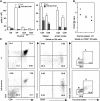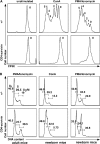Essential role of survivin, an inhibitor of apoptosis protein, in T cell development, maturation, and homeostasis
- PMID: 14699085
- PMCID: PMC1887718
- DOI: 10.1084/jem.20031588
Essential role of survivin, an inhibitor of apoptosis protein, in T cell development, maturation, and homeostasis
Abstract
Survivin is an inhibitor of apoptosis protein that also functions during mitosis. It is expressed in all common tumors and tissues with proliferating cells, including thymus. To examine its role in apoptosis and proliferation, we generated two T cell-specific survivin-deficient mouse lines with deletion occurring at different developmental stages. Analysis of early deleting survivin mice showed arrest at the pre-T cell receptor proliferating checkpoint. Loss of survivin at a later stage resulted in normal thymic development, but peripheral T cells were immature and significantly reduced in number. In contrast to in vitro studies, loss of survivin does not lead to increased apoptosis. However, newborn thymocyte homeostatic and mitogen-induced proliferation of survivin-deficient T cells were greatly impaired. These data suggest that survivin is not essential for T cell apoptosis but is crucial for T cell maturation and proliferation, and survivin-mediated homeostatic expansion is an important physiological process of T cell development.
Figures







Similar articles
-
Survivin loss in thymocytes triggers p53-mediated growth arrest and p53-independent cell death.J Exp Med. 2004 Feb 2;199(3):399-410. doi: 10.1084/jem.20032092. J Exp Med. 2004. PMID: 14757745 Free PMC article.
-
Survivin expression correlates with apoptosis resistance after lymphocyte activation and is found preferentially in memory T cells.Immunol Lett. 2001 Apr 2;76(3):169-73. doi: 10.1016/s0165-2478(01)00186-9. Immunol Lett. 2001. PMID: 11306144
-
Therapeutic targeting of the survivin pathway in cancer: initiation of mitochondrial apoptosis and suppression of tumor-associated angiogenesis.Clin Cancer Res. 2003 Jul;9(7):2683-92. Clin Cancer Res. 2003. PMID: 12855648
-
Survivin: key regulator of mitosis and apoptosis and novel target for cancer therapeutics.Clin Cancer Res. 2008 Aug 15;14(16):5000-5. doi: 10.1158/1078-0432.CCR-08-0746. Clin Cancer Res. 2008. PMID: 18698017 Review.
-
Survivin: a protein with dual roles in mitosis and apoptosis.Int Rev Cytol. 2005;247:35-88. doi: 10.1016/S0074-7696(05)47002-3. Int Rev Cytol. 2005. PMID: 16344111 Review.
Cited by
-
Suppressed diversity of survivin splicing in active rheumatoid arthritis.Arthritis Res Ther. 2015 Jul 10;17:175. doi: 10.1186/s13075-015-0689-z. Arthritis Res Ther. 2015. PMID: 26160473 Free PMC article.
-
Lack of endothelial cell survivin causes embryonic defects in angiogenesis, cardiogenesis, and neural tube closure.Blood. 2007 Jun 1;109(11):4742-52. doi: 10.1182/blood-2006-06-028068. Epub 2007 Feb 13. Blood. 2007. PMID: 17299096 Free PMC article.
-
Serum survivin predicts responses to treatment in active rheumatoid arthritis: a post hoc analysis from the SWEFOT trial.BMC Med. 2015 Sep 30;13:247. doi: 10.1186/s12916-015-0485-2. BMC Med. 2015. PMID: 26420684 Free PMC article.
-
Subcellular Localization of Survivin Determines Its Function in Cardiomyocytes.Theranostics. 2017 Oct 13;7(18):4577-4590. doi: 10.7150/thno.20005. eCollection 2017. Theranostics. 2017. PMID: 29158846 Free PMC article.
-
1,1-Bis(3'-indolyl)-1-(p-bromophenyl)methane and related compounds repress survivin and decrease gamma-radiation-induced survivin in colon and pancreatic cancer cells.Int J Oncol. 2009 Nov;35(5):1191-9. doi: 10.3892/ijo_00000436. Int J Oncol. 2009. PMID: 19787275 Free PMC article.
References
-
- von Boehmer, H. 1994. Positive selection of lymphocytes. Cell. 76:219–228. - PubMed
-
- Sohn, S.J., A. Rajpal, and A. Winoto. 2003. Apoptosis during lymphoid development. Curr. Opin. Immunol. 15:209–216. - PubMed
-
- Ceredig, R. 1990. Intrathymic proliferation of perinatal mouse alpha beta and gamma delta T cell receptor-expressing mature T cells. Int. Immunol. 2:859–867. - PubMed
-
- Krammer, P.H. 2000. CD95's deadly mission in the immune system. Nature. 407:789–795. - PubMed
Publication types
MeSH terms
Substances
Grants and funding
LinkOut - more resources
Full Text Sources
Other Literature Sources
Molecular Biology Databases

